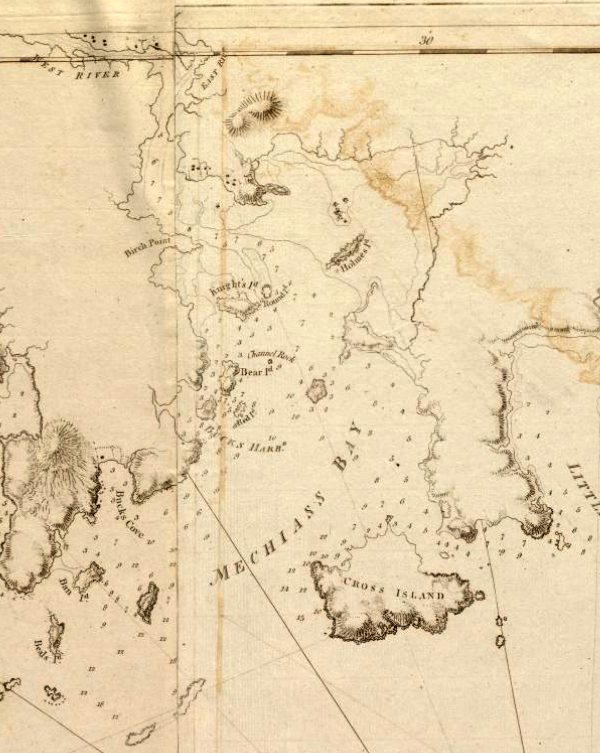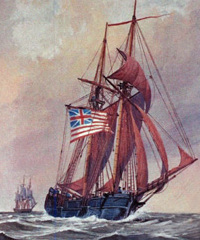|
Battle Of Machias
The Battle of Machias (June 11–12, 1775) was an early naval engagement of the American Revolutionary War, also known as the Battle of the ''Margaretta'', fought around the port of Machias, Maine. Following the outbreak of the war, British authorities enlisted Loyalist merchant Ichabod Jones to supply the troops who were under the Siege of Boston. Two of his merchant ships arrived in Machias on June 2, 1775, accompanied by the British armed sloop HMS ''Margaretta'' (sometimes also spelled ''Margueritta'' or ''Marguerite''), commanded by Midshipman James Moore. The townspeople of Machias disapproved of Jones' intentions and arrested him. They also tried to arrest Moore, but he escaped through the harbor. The townspeople seized one of Jones' ships, armed it alongside a second local ship, and sailed out to meet Moore. After a short confrontation, Moore was fatally wounded, and his vessel and crew were captured. The people of Machias captured additional British ships, and foug ... [...More Info...] [...Related Items...] OR: [Wikipedia] [Google] [Baidu] |
American Revolutionary War
The American Revolutionary War (April 19, 1775 – September 3, 1783), also known as the Revolutionary War or American War of Independence, was a major war of the American Revolution. Widely considered as the war that secured the independence of the United States, fighting began on April 19, 1775, followed by the Lee Resolution on July 2, 1776, and the Declaration of Independence on July 4, 1776. The American Patriots were supported by the Kingdom of France and, to a lesser extent, the Dutch Republic and the Spanish Empire, in a conflict taking place in North America, the Caribbean, and the Atlantic Ocean. Established by royal charter in the 17th and 18th centuries, the American colonies were largely autonomous in domestic affairs and commercially prosperous, trading with Britain and its Caribbean colonies, as well as other European powers via their Caribbean entrepôts. After British victory over the French in the Seven Years' War in 1763, tensions between the motherland and he ... [...More Info...] [...Related Items...] OR: [Wikipedia] [Google] [Baidu] |
Battles Of Lexington And Concord
The Battles of Lexington and Concord were the first military engagements of the American Revolutionary War. The battles were fought on April 19, 1775, in Middlesex County, Province of Massachusetts Bay, within the towns of Lexington, Concord, Lincoln, Menotomy (present-day Arlington), and Cambridge. They marked the outbreak of armed conflict between the Kingdom of Great Britain and its thirteen colonies in America. In late 1774, Colonial leaders adopted the Suffolk Resolves in resistance to the alterations made to the Massachusetts colonial government by the British parliament following the Boston Tea Party. The colonial assembly responded by forming a Patriot provisional government known as the Massachusetts Provincial Congress and calling for local militias to train for possible hostilities. The Colonial government effectively controlled the colony outside of British-controlled Boston. In response, the British government in February 1775 declared Massachusetts to be in a ... [...More Info...] [...Related Items...] OR: [Wikipedia] [Google] [Baidu] |
Breastwork (fortification)
A breastwork is a temporary fortification, often an earthwork thrown up to breast height to provide protection to defenders firing over it from a standing position. A more permanent structure, normally in stone, would be described as a parapet or the battlement of a castle wall. In warships, a breastwork is the armored superstructure in the ship that did not extend all the way out to the sides of the ship. It was generally only used in ironclad turret ships designed between 1865 and 1880. See also *List of established military terms (Fortifications A fortification is a military construction or building designed for the defense of territories in warfare, and is also used to establish rule in a region during peacetime. The term is derived from Latin ''fortis'' ("strong") and ''facere'' ...) Fortifications by type {{Fort-stub ... [...More Info...] [...Related Items...] OR: [Wikipedia] [Google] [Baidu] |
East Machias
East Machias is a town in Washington County, Maine, United States on the East Machias River. At the 2020 census, the town population was 1,326. It is the home of Washington Academy, a private school founded in 1792. Geography According to the United States Census Bureau, the town has a total area of , of which, of it is land and is water. Demographics 2014 American Community Survey As of the 2014 American Community Survey the largest self-reported ethnic/ancestry groups in the town of East Machias were English at 24.4%, Irish at 15.4%, German at 14.4% and those who identified as being American ancestry at 7.1%. 2010 census As of the census of 2010, there were 1,368 people, 582 households, and 377 families living in the town. The population density was . There were 845 housing units at an average density of . The racial makeup of the town was 95.9% White, 0.8% African American, 0.3% Native American, 1.7% Asian, and 1.3% from two or more races. Hispanic or Latino of any ... [...More Info...] [...Related Items...] OR: [Wikipedia] [Google] [Baidu] |
Battle Of Machias
The Battle of Machias (June 11–12, 1775) was an early naval engagement of the American Revolutionary War, also known as the Battle of the ''Margaretta'', fought around the port of Machias, Maine. Following the outbreak of the war, British authorities enlisted Loyalist merchant Ichabod Jones to supply the troops who were under the Siege of Boston. Two of his merchant ships arrived in Machias on June 2, 1775, accompanied by the British armed sloop HMS ''Margaretta'' (sometimes also spelled ''Margueritta'' or ''Marguerite''), commanded by Midshipman James Moore. The townspeople of Machias disapproved of Jones' intentions and arrested him. They also tried to arrest Moore, but he escaped through the harbor. The townspeople seized one of Jones' ships, armed it alongside a second local ship, and sailed out to meet Moore. After a short confrontation, Moore was fatally wounded, and his vessel and crew were captured. The people of Machias captured additional British ships, and foug ... [...More Info...] [...Related Items...] OR: [Wikipedia] [Google] [Baidu] |
Thompson's War
Thompson's War was an early American Revolutionary War confrontation between Samuel Thompson's patriot militia and loyalists supported by HMS ''Canceaux''. The confrontation ended without fatalities, but provoked the retaliatory Burning of Falmouth five months later. Falmouth is now known as Portland, Maine, but Maine was part of Massachusetts at the time. Background Brunswick, Maine tavern owner Samuel Thompson had been elected to the Brunswick Board of selectmen in 1768, 1770, and 1771. He was elected commander of the Brunswick militia in 1774 and headed the local enforcement committee for the Continental Association created by the First Continental Congress to boycott all goods from Great Britain. The Continental Association attempted to enforce the boycott on 2 March 1775 against a shipload of sail, rope, and rigging for loyalist shipbuilder Captain Samuel Coulson of Portland by demanding the delivery ship leave port. Coulson requested delay while the English sloop compl ... [...More Info...] [...Related Items...] OR: [Wikipedia] [Google] [Baidu] |
Brunswick, Maine
Brunswick is a town in Cumberland County, Maine, United States. The population was 21,756 at the 2020 United States Census. Part of the Portland-South Portland-Biddeford metropolitan area, Brunswick is home to Bowdoin College, the Bowdoin International Music Festival, the Bowdoin College Museum of Art, the Peary-MacMillan Arctic Museum, and the Maine State Music Theatre. It was formerly home to the U.S. Naval Air Station Brunswick, which was permanently closed on May 31, 2011, and has since been partially released to redevelopment as "Brunswick Landing". History Settled in 1628 by Thomas Purchase and other fishermen, the area was called by its Indian name, Pejepscot, meaning "the long, rocky rapids part f the river. In 1639, Purchase placed his settlement under protection of the Massachusetts Bay Colony. During King Philip's War in 1676, Pejepscot was burned and abandoned, although a garrison called Fort Andros was built on the ruins during King William's War. During ... [...More Info...] [...Related Items...] OR: [Wikipedia] [Google] [Baidu] |
Duncan
Duncan may refer to: People * Duncan (given name), various people * Duncan (surname), various people * Clan Duncan * Justice Duncan (other) Places * Duncan Creek (other) * Duncan River (other) * Duncan Lake (other), including Lake Duncan Australia *Duncan, South Australia, a locality in the Kangaroo Island Council *Hundred of Duncan, a cadastral unit on Kangaroo Island in South Australia Bahamas *Duncan Town, Ragged Island, Bahamas ** Duncan Town Airport Canada * Duncan, British Columbia, on Vancouver Island * Duncan Dam, British Columbia * Duncan City, Central Kootenay, British Columbia; see List of ghost towns in British Columbia United States * Duncan Township (other) * Duncan, Arizona * Duncan, Indiana * Duncan, Iowa * Duncan, Kentucky (other) * Duncan City, Cheboygan, Michigan * Duncan, Mississippi * Duncan, Missouri * Duncan, Nebraska * Duncan, North Carolina * Duncan, Oklahoma * Duncan, South Carolina * Fo ... [...More Info...] [...Related Items...] OR: [Wikipedia] [Google] [Baidu] |
Barracks
Barracks are usually a group of long buildings built to house military personnel or laborers. The English word originates from the 17th century via French and Italian from an old Spanish word "barraca" ("soldier's tent"), but today barracks are usually permanent buildings for military accommodation. The word may apply to separate housing blocks or to complete complexes, and the plural form often refers to a single structure and may be singular in construction. The main object of barracks is to separate soldiers from the civilian population and reinforce discipline, training, and ''esprit de corps''. They have been called "discipline factories for soldiers". Like industrial factories, some are considered to be shoddy or dull buildings, although others are known for their magnificent architecture such as Collins Barracks in Dublin and others in Paris, Berlin, Madrid, Vienna, or London. From the rough barracks of 19th-century conscript armies, filled with hazing and illness and bare ... [...More Info...] [...Related Items...] OR: [Wikipedia] [Google] [Baidu] |
Samuel Graves
Admiral Samuel Graves (17 April 1713 – 8 March 1787) was a British Royal Navy admiral who is probably best known for his role early in the American Revolutionary War. Ancestry He is thought to have been born in Castledawson, Northern Ireland. His grandfather Captain James Graves (1654–1689) was murdered in his bed and robbed of his regiment's wages. Samuel Graves was born the youngest son and presumably second youngest child of Captain Graves' son Samuel Graves (1674–1727) and his wife Jane Moore. He had three older brothers and a sister. By joining the Royal Navy, he followed in the footsteps of his uncle Thomas Graves, whose son Thomas Graves is most well-known for having commanded the British fleet at the Battle of the Chesapeake during the American War of Independence. Another Thomas Graves, a nephew to Samuel Graves, was knighted following the Battle of Copenhagen in 1801, where he had served as Horatio Nelson's second-in-command. A number of Graves' served in t ... [...More Info...] [...Related Items...] OR: [Wikipedia] [Google] [Baidu] |
Thomas Gage
General Thomas Gage (10 March 1718/192 April 1787) was a British Army general officer and colonial official best known for his many years of service in North America, including his role as British commander-in-chief in the early days of the American Revolution. Being born to an aristocratic family in England, he entered military service, seeing action in the French and Indian War, where he served alongside his future opponent George Washington in the 1755 Battle of the Monongahela. After the Conquest of 1760, fall of Montreal in 1760, he was named its military governor. During this time he did not distinguish himself militarily, but proved himself to be a competent administrator. From 1763 to 1775 he served as commander-in-chief of the British forces in North America, overseeing the British response to the 1763 Pontiac's War, Pontiac's Rebellion. In 1774 he was also appointed the military governor of the Province of Massachusetts Bay, with instructions to implement the Intol ... [...More Info...] [...Related Items...] OR: [Wikipedia] [Google] [Baidu] |






